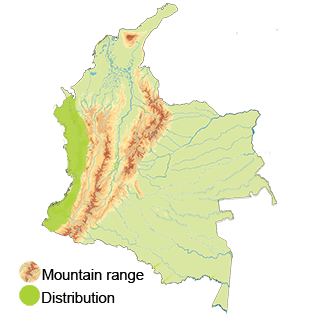Dusky Pigeon
The Dusky Pigeon (Patagioenas goodsoni). Read in Spanish
Appearance: The Dusky Pigeon is a medium-sized pigeon with a dusky gray plumage, which appears more brownish on its wings and back. It has distinctive white markings on its wings, displaying a white patch on each wing when in flight. The species has red feet and legs, orange eyes, and a pale gray forehead.
Habitat: The Dusky Pigeon is primarily found in montane forests and cloud forests in the Central and Eastern Andes of Colombia. It can be observed at elevations ranging from 1100 to 1500 meters above sea level.
Behavior: These pigeons are often found in pairs or small groups, foraging in the forest canopy for fruits and seeds. They are known to be secretive and elusive, making them challenging to spot in the wild.
Breeding: Breeding habits of the Dusky Pigeon include building nests on tree branches using sticks and twigs. The female typically lays one or two eggs per clutch, and both parents share the incubation and care of the young.
Conservation Status: The Dusky Pigeon is considered globally near-threatened by the International Union for Conservation of Nature (IUCN).
Distribution
The Dusky Pigeon (Patagioenas goodsoni) is a bird species that is predominantly found in the Western Andes of Colombia.
Specific locations within this region where the Dusky Pigeon may be found include national parks, nature reserves, and protected areas that offer suitable habitat for the species.
Taxonomy
The Dusky Pigeon (Patagioenas goodsoni)
- Kingdom: Animalia
- Phylum: Chordata
- Class: Aves (Birds)
- Order: Columbiformes
- Family: Columbidae
- Genus: Patagioenas
- Species: Patagioenas goodsoni
Vocalization
The vocalizations of the Dusky Pigeon (Patagioenas goodsoni) are not extensively documented compared to some other bird species. The Dusky Pigeon likely produces a range of vocalizations for various purposes, including communication, mate attraction, and territorial defense.
- Cooing Sounds: Pigeons are renowned for their gentle and soothing cooing sounds, which are often used in courtship displays and communication with other birds nearby. These coos can vary in pitch and rhythm, and they may be repeated in a rhythmic pattern.
- Soft Calls: Pigeons also emit soft calls that serve as contact calls to maintain communication among members of a group or pair. These calls can be short, gentle chirps or murmurs exchanged between individuals.
- Alarm Calls: When threatened or disturbed, pigeons may produce alarm calls to alert others in the vicinity of potential danger. These alarm calls are typically sharper and more urgent than their regular vocalizations.
- Breeding Calls: During the breeding season, pigeons may exhibit specific vocalizations associated with courtship and nest-building activities. These calls can be more elaborate and may be part of their reproductive behavior.




